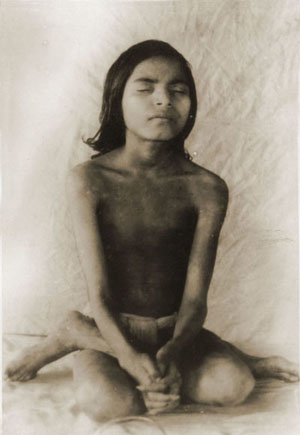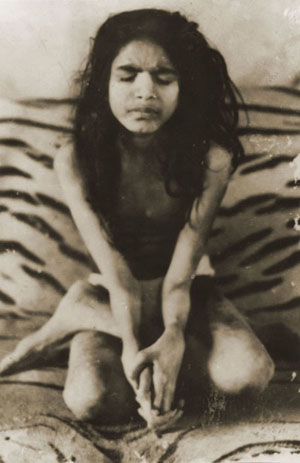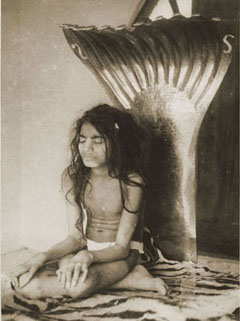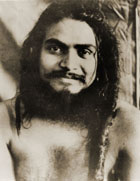![]()
|
|
PRINTER FRIENDLY PDF
FIRST PAGE │
PREVIOUS CHAPTER │
NEXT CHAPTER
Sri Shivabalayogi
3.
Tapas
by Prof. S. K. Ramachandra Rao
Download printer-friendly PDF of
Sri Shivabalayogi (1968)
By this time the villagers had concluded that Sathyaraju had now become a Yogi. They understood that his unconscious state was nothing other than Samadhi. They no doubt felt it was extraordinary for a young boy of only 14 to become a yogi; but they realized that it was not impossible. They treated Sathraraju, seated motionless in Padmasana under the palmyra leaf Mantap on the Godavari canal bund, as the boy-ascetic (Balayogi).
Considering him a Yogi, the villagers now began to look after him well. At that time the yogi was taking only milk. Gora Mallanna grew jealous at the kind treatment given to the Yogi by the village folk. It may be recalled that he did not take kindly to the boy and had beaten him with a club when he was in Samadhi; he now pretended repentance and devotion and offered to stay as his caretaker. However, he started by finishing up the milk and bananas brought by the villagers for the yogi, when the yogi was in constant meditation. He would eat the plantains but keep the skins thereof near the yogi. The people naturally thought that the yogi himself had eaten their offerings. Out of jealousy, he would encourage the yogi to increase the intensity of his TAPAS. He suggested that the yogi should give up even milk and fruits and thus observe complete fast. And the yogi agreed and intensified his tapas. This put his mother, Parvatamma, in great distress. Gora Mallanna who had successfully prevented her from bringing the milk, now prevailed on her not to come to see the yogi either. When the yogi came to know of this, mental agony was added to his physical suffering. The yogi however put up with all these, and continued his tapas, with steadfast devotion.
 At Adivarapupeta, there was a man, Dora Viraraju by name, was going around telling the people that the Balayogi was after all an imposter. He had a friend in Chinta Suranna, an Ayurvedic Pundit, who lived in Someshwara near Ramachandrapuram. The two conspired and connived to expose the Balayogi. One night, when the yogi was sitting under the pandal, Chinta Surabba came there ostensibly wanting to have his darshan. When those who had gathered left, and the yogi was alone, he tried to unlock the yogi’s padmasana posture in order to test the intensity of his sadhana. He pulled out the legs but they remained open where they were left! He tried to open the closed eyelids, and raised one of them with his
finger but it remained there half opened! Suranna now tried to put him back into padmasana and tried to close the half-opened eyelid. He struggled for the whole night, but did not succeed. Fearing that his ill treatment of the yogi would come to light, when the villagers came in the morning, he begged his pardon and touched his feet. The yogi smiled, and readily pardoned him. On his way back, Suranna met Parvatamma and told her that her son was a real “MAHATMA” and entreated her to look after him well.
At Adivarapupeta, there was a man, Dora Viraraju by name, was going around telling the people that the Balayogi was after all an imposter. He had a friend in Chinta Suranna, an Ayurvedic Pundit, who lived in Someshwara near Ramachandrapuram. The two conspired and connived to expose the Balayogi. One night, when the yogi was sitting under the pandal, Chinta Surabba came there ostensibly wanting to have his darshan. When those who had gathered left, and the yogi was alone, he tried to unlock the yogi’s padmasana posture in order to test the intensity of his sadhana. He pulled out the legs but they remained open where they were left! He tried to open the closed eyelids, and raised one of them with his
finger but it remained there half opened! Suranna now tried to put him back into padmasana and tried to close the half-opened eyelid. He struggled for the whole night, but did not succeed. Fearing that his ill treatment of the yogi would come to light, when the villagers came in the morning, he begged his pardon and touched his feet. The yogi smiled, and readily pardoned him. On his way back, Suranna met Parvatamma and told her that her son was a real “MAHATMA” and entreated her to look after him well.
Balayogi remained in this place for two months after the divine experience. Many grew jealous on seeing the treatment he received from the village and tried to torment him in several ways. Some stealthily came and beat him. Some persons once dipped a piece of cloth in kerosene, lit it and threw it on the left leg of the yogi; the scar of the burnt skin can be seen even to this day. As result of all this he found it difficult to stay there and retired to another village Pasalapudi, five miles away where a Sadhu had built an ashram. It was evening when he reached this ashram. Balayogi met the Sadhu, who was the chief of the ashram, narrated the troubles he encountered during his stay at Adivarapupeta and requested him to allow him to stay in the ashram. This Sadhu was of a deceitful nature and looked upon the yogi with suspicion. Before providing accommodation for him he asked the yogi, “What is the meditation you are doing?” Balayogi replied, “I do not know.” He had told the truth: it was spontaneous Sahaja Samadhi which he experienced. Then the sadhu suggested: “If that be so, I shall initiate you to a mantra” and gave him the mantra “SADGURU.” Early next morning the Sadhu came and asked him if he chanted the mantra that was given to him. The yogi replied in the negative. The Sadhu was annoyed. “All right, what is your diet?” he asked the yogi. The yogi replied that it was milk. Thereupon the Sadhu said, “That is not the food of the ashramites here. It is not available either. You need not stay here.” The same day the Balayogi returned to Adivarapupeta and posted himself again under the old Banyan tree.
 Thus time passed on. One night during November 1945 at 2:30 a.m., there blew a severe tempest, followed by torrential rains which continued unabated till 5:30 a.m. The whole country was in trouble. Hundreds of trees were uprooted, houses collapsed and the people were in great distress. When the rains and the gale subsided, the yogi’s mother Parvatamma ran to the canal bund; she was naturally anxious of her son. But she found to her surprise that the boy was sitting under the Banyan tree, lost in meditation and the rains and storm which raged like a deluge had not disturbed his samadhi. Not only that, there was not the slightest disturbance under the banyan tree; not even a leaf had moved; the place where the yogi sat had remained clean and calm as before. But armies of red ants, which usually crop up after rains, were freely running in swarms over his body. Parvatamma could not stand this sight; she began brushing away the ants from his body. But the yogi signaled here not to do so.
Thus time passed on. One night during November 1945 at 2:30 a.m., there blew a severe tempest, followed by torrential rains which continued unabated till 5:30 a.m. The whole country was in trouble. Hundreds of trees were uprooted, houses collapsed and the people were in great distress. When the rains and the gale subsided, the yogi’s mother Parvatamma ran to the canal bund; she was naturally anxious of her son. But she found to her surprise that the boy was sitting under the Banyan tree, lost in meditation and the rains and storm which raged like a deluge had not disturbed his samadhi. Not only that, there was not the slightest disturbance under the banyan tree; not even a leaf had moved; the place where the yogi sat had remained clean and calm as before. But armies of red ants, which usually crop up after rains, were freely running in swarms over his body. Parvatamma could not stand this sight; she began brushing away the ants from his body. But the yogi signaled here not to do so.
Somehow the yogic practices continued there. But the Balayogi found it difficult to stay in that place. On 18th November 1948, he shifted from there and entered the burial ground, situated on the outskirts of the village. Mischievous boys were scared of the new venue and did not go there; he was, more or less free from their torments. The tranquility of the burial ground was congenial to his Sahaja Samadhi. But life in the burial ground was not altogether comfortable. When he sat on the floor for meditation he was tormented by rodents, squirrels and wild insects. As he sat motionless for several hours at a stretch, these creatures began biting his fingers taking his body to be lifeless. Mosquitoes settled on his body freely sucking his blood. Now and then, several snakes bit him and caused him pain. It was his practice at midnight to go to the canal for a bath, unnoticed. As his body was covered with wounds due to the animal bites, fish used to nibble at them while bathing. At other times swarms of ants enveloped him. If it was the torment by the mischievous boys in the village, it was the torment of the animals in the burial ground; in the water it was the torment of the fish; indeed the yogi’s plight was miserable beyond description.
One night, while he was on his way for the usual midnight bath a deadly serpent bit his leg; blood was dripping from the wound. Ignoring this, he went to the canal, took his bath and returned. In the meantime the deadly poison spread all over his body, which now turned blue. Gangrene had set in due to the poison and foul smell proceeded from the wound. The pain became unbearable for the yogi; it became difficult either to meditate or to concentrate his mind in Samadhi. There was burning sensation all over his body and he began to weep, unable to bear the pain any longer. Then he was only 14 years of age; it was only four months since he entered into this extraordinary life. In this intolerable situation, the boy’s determination wavered. He resolved to put an end to this yogic life and return home. He felt that it was not correct to live like a ghost while still alive, in a burial ground, undergoing such difficulties. He thought it better to return home and lead a normal life in the village like others. But his yogic life had begun in spite of himself, and he had not sought it. He was lost in meditation after obtaining spontaneous real Samadhi, without any effort on his part. It was not left to his choice, therefore to decide whether or not to follow the path of yoga. The stranger who had appeared before him four months ago when he had the divine experience, once again appeared and commanded him not to return home but to continue the yogic life. He decided thereupon to die in the yogic path rather than return home as a “Yogabhrashta” (one who has failed in yogic practice). This decision relieved his mental agony immediately.
In a way this incident was remarkable. When it was beyond the capacity of the yogi to bear the physical pain, he received help from unknown quarters. Not only did the stranger appear before him and infuse courage into him but also initiated him to a manta which soothed the physical suffering, facilitating him to hold on to his “SAMADHI”. By constant chanting of the mantra the poison in his body lost its sting; the normal skin colour was regained, and the pain disappeared. Immediately thereafter he went into “DHYANA SAMADHI”.
 The news that the Balayogi who was in the burial ground was unaffected, though a poisonous serpent had bit him, reached the District Collector of East Godavari. He was a man of religious disposition and was interested in spiritual practices. On hearing this strange news, he resolved to have a darshan of this Balayogi. Before leaving, he inquired if he could be of any service to the yogi. The Balayogi was then squatting on the bare ground for his meditation. One had to use a deerskin or tiger skin for meditation as ordained in the Shastras. The yogi asked the Collector to send a tiger skin for his use. The Collector caused one to be sent to the yogi the very next day through Garaga Narasimha Murthy, Tehsildar of Ramachandrapuram. Narasimha Murthy, who went to the burial ground to give the tiger skin, saw the yogi sitting on the wet ground. Realising that the tiger skin would emanate a bad smell if spread on such a ground, he got a wooden platform constricted and spread the tiger skin on it. He also got a small pandal of palmyra leaves built over the platform. This relieved the yogi from the torments of rodents, ants and insects to a great extent. Meditation progressed undisturbed. T he yogi lived for one and a half years in the improvised hut on the burial ground.
The news that the Balayogi who was in the burial ground was unaffected, though a poisonous serpent had bit him, reached the District Collector of East Godavari. He was a man of religious disposition and was interested in spiritual practices. On hearing this strange news, he resolved to have a darshan of this Balayogi. Before leaving, he inquired if he could be of any service to the yogi. The Balayogi was then squatting on the bare ground for his meditation. One had to use a deerskin or tiger skin for meditation as ordained in the Shastras. The yogi asked the Collector to send a tiger skin for his use. The Collector caused one to be sent to the yogi the very next day through Garaga Narasimha Murthy, Tehsildar of Ramachandrapuram. Narasimha Murthy, who went to the burial ground to give the tiger skin, saw the yogi sitting on the wet ground. Realising that the tiger skin would emanate a bad smell if spread on such a ground, he got a wooden platform constricted and spread the tiger skin on it. He also got a small pandal of palmyra leaves built over the platform. This relieved the yogi from the torments of rodents, ants and insects to a great extent. Meditation progressed undisturbed. T he yogi lived for one and a half years in the improvised hut on the burial ground.
The District Collector of East Godavari District who came to meet the yogi again on the eve of his transfer, had his assistant Sri T. V. Sathyanarayana Rao also accompanying him. The latter was greatly impressed by the Balayogi. The very next day he met Garaga Narasimha Murthy, the Tehsildar, and discussed with him a proposal to build a “Mandir” for the yogi. The site adjoining the burial ground belonged to Vattakoota Pattabhiramanna, the Zamindar of Vella. Sathyanarayana Rao and Narasimha Murthy discussed with the Zamindar the proposal to put up a mandir. The Zamindar agreed to have the mandir on his own site.
In fulfillment of their desire, by October 1950, a mandir measuring 12 ft. by 12 ft was constructed on the burial ground of Adivarapupeta. After the mandir was ready, the Balayogi was bodily lifted in his sitting posture and placed on the platform inside the mandir. At that time the yogi had lost control of his hands and legs; he was unable to walk. His hands and legs had become rigid as he sat motionless for a long period, and he was taking for nourishment nothing but milk. The people responsible for the construction of the mandir locked the door so as to enable the yogi to continue his meditation without hindrance, and left the key with his mother Parvatamma.
Download printer-friendly PDF of Sri Shivabalayogi (1968)
